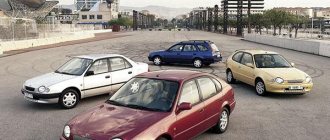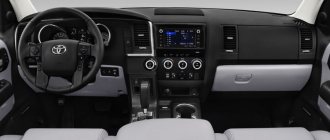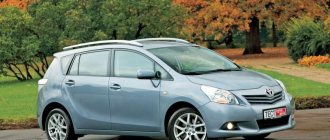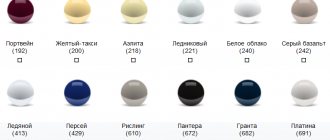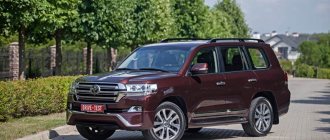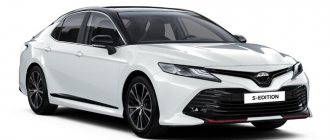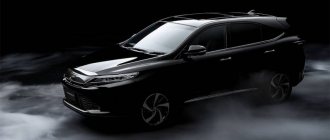What is more in the Toyota Prius - practicality or innovation? Is this hybrid easy to use or is it still a high-tech toy? We all know Isaac Asimov's formula: a robot cannot harm a person. Can it be beneficial?
Before I met the Prius, I drove four hybrid cars, and none of them gave a clear answer to these questions. Yes, it was interesting to observe how energy flows were redistributed while moving: all models provided a visual indication of the processes. Sometimes operation showed that energy redistribution was taking place, since there was real fuel savings. In the case of the only plug-in hybrid, the “cartoons” on the displays were incredibly bright and rich, but the car seemed to have forgotten that it had an additional electric motor and consumed hydrocarbon fuel in the same quantities as it would have done if it had been armed with 2 .5-liter gasoline engine.
Exterior Toyota Prius 50 body, 4th generation
The aggressive appearance of the front of the car makes it look like a cheetah crouched and ready to jump.
Toyota Prius 50 body, 4th generation front view
Predatory optics, vertical fog lights made in the form of vertically arranged triangles and sliding down turn signals - all this makes the car’s appearance memorable.
Toyota Prius 50 body, 4th generation front left view
The side glazing is made in the form of a triangle, the apex of which falls on the center of the front door, after which a smooth descent begins to the extreme point of the trunk door, inherent in classic liftbacks.
Toyota Prius 50 body, 4th generation rear view
The rear part may seem original. The bottom of the trunk is made in the form of a cut, allowing you not to worry about the integrity of the bumper when parking over high curbs.
Interesting! Although the Toyota Prius, even in the minimum configuration, comes with alloy wheels, they are covered with plastic caps. This increases the aerodynamic characteristics of the car.
Interior of Toyota Prius 50 body, 4th generation
The futuristic interior of the fourth generation Prius is designed to provide maximum comfort.
Toyota Prius 50 body, 4th generation interior
Salon
The huge multifunction screen is shifted to the center, closer to the windshield, the media system display is installed in its place, but may differ in size (6, 7 or 9 inches), depending on the model configuration.
Dashboard
The projection of basic information is displayed on the windshield, which allows the driver not to be distracted from the road while driving.
Projection of the speedometer onto the windshield
The visibility was improved due to increased glazing and a lower hood line. Speed switching is carried out by a multi-position switch operating on the principle of a computer joystick.
Selector (gear knob)
A fully equipped security system requires special attention. Already in the standard version of the Toyota Prius in the 50th body has 7 airbags.
The note! The ease of seating, free space above the head and in the legs does not cause any complaints. Together with the light upholstery, which increases the space even longer, everything looks very impressive.
What do you need to know?
An unusual solution: a touch screen and an oval steering wheel.
Toyota Prius has two electrical circuits. One, traditional - with a regular 12-volt battery. The other, high voltage, has orange wires connecting a tightly closed group of batteries (generating a voltage of 201.6 V) to the inverter-converter, electric motor and air conditioning unit.
An inverter-converter is a device that amplifies and converts the high DC voltage of the battery pack into three-phase alternating current (maximum voltage 650 V). In addition, the inverter converts the alternating current generated by energy recovery into direct current to charge the batteries.
The Toyota Prius air conditioning system is a complex responsible not only for cooling the interior, but also, above all, for cooling the battery pack, which gets very hot during operation. The Prius is not afraid of cold winters, but a failure of the air conditioner in the summer can completely immobilize the hybrid. The on-board computer strictly monitors the temperature, preventing overheating, and, in extreme cases, locks the car. Strict monitoring is necessary due to the irreversible reduction in battery life in case of overheating. In addition, Toyota limited itself to a not too long warranty - 8 years or 160,000 km.
Design and principle of operation of a hybrid installation
The main hybrid engine is the new modular TNGA platform, which combines several main components:
- ICE.
- An electric motor that can act as a generator.
- Electric generator.
- Planetary gear.
- Battery
- Inverter.
- An energy distributor that converts a planetary gear into something like a variator.
Hybrid installation device
The operation of the car is based on the series-parallel principle of operation of a hybrid installation. The main role is played by the gasoline engine. For a short period of time, the car becomes an electric vehicle with the internal combustion engine stopped.
Find out how a hybrid works
The basic operating principle of a hybrid engine is as follows:
1. As a result of rotation of the gearbox, torque is transmitted to the wheels, thereby influencing the starting and acceleration of the car.
2. When driving smoothly, the internal combustion engine operates. When overtaking or otherwise accelerating, the electric motor helps the gasoline one.
3. When braking and reversing, the internal combustion engine is switched off and the electric one is activated.
Reference! Due to the combined use of two engines, the efficiency of the machine reaches maximum values. Movement control occurs bypassing complex aggregate mechanisms. The generator acts as a starter.
What breaks?
With proper care and timely maintenance, the Prius is virtually trouble-free and very durable. The energy recovery system relieves the brake system during braking. In some instances, factory pads and discs last up to 100,000 km.
Gasoline engines, as well as the electrical part, are famous for their reliability. The internal combustion engine has a maintenance-free chain. Typical operations (changing pads, oil and shock absorbers) can be performed at any automotive service center that has a basic understanding of working with hybrid or electric vehicles.
The continuously variable transmission rarely needs repair or replacement.
The battery has 28 modules, each of which contains 6 cells. Most often, only one or two modules fail (2-4 thousand rubles for a used one). This usually happens after 200-250 thousand km. A complete set of “contract” high-voltage batteries will cost 80-100 thousand rubles. This is a lot, but not as much as it might seem. Yes, the first generation model had problems with battery life. But the next Prius received an upgraded battery, which turned out to be more durable. Usually it is enough to replace the “weak” element.
An additional circuit of the cooling system is involved in cooling the inverter. After 250-300 thousand km, the cooling pump of the hybrid transmission may fail (5-10 thousand rubles). A number of cars were subject to a recall campaign to replace the vulnerable pump.
Description of the operating modes of the hybrid power plant
The installation has 4 operating modes:
1. EVO mode
Economy, only electric traction is used. Maximum speed is up to 60 km/h in summer and no more than 30 km/h in winter.
2. ECO mode
Used when driving in traffic jams. Provides maximum efficiency when using both power units together.
3.Normal
Standard operating mode.
4. Power mode
Maximum efficiency mode provides maximum power and fuel consumption.
Attention! Despite the claim of maximum savings in ECO mode, frequent pressing of the gas pedal does not greatly affect fuel economy.
“And the counter is clicking...”
The Prius power plant circuit has been the same for many years, but the components change. The gasoline engine under the hood is the same as before, with the index 2ZR-FXE, its displacement is 1.8 liters and the power is 98 hp. With. When designed for Russia, it easily digests 92-octane gasoline, whereas in other countries it must be fed 95-octane. The electric motor in the Prius is new; it develops 53 kW (72 hp), which is 8 kW less than before. The electric motor is made in the same housing with a variator. According to the manufacturer, the updated power plant has reduced fuel consumption by 5 percent.
Please note: the registration certificate of the test Prius only showed the power of the gasoline engine - 98 hp. With. An assistant in the form of an electric motor does not seem to exist. But in fact, it helps with overclocking, and very significantly!
The Prius silently indicates when it is ready to move. Press the Start/Stop Engine button - look for the green READY sign on the instrument panel. That's it, you can go. The electric motor does not require any warm-up. Of course, you won't move unless you move the blue knob to D (or R) and release the electronic parking brake. The selector moves along its grooves very easily, and gradually you will get used to casually pushing it into the desired position, with almost no effort. The exception is mode N, you have to literally catch it. I got used to doing this: when the selector is in the central position, I move it to the left, to the N symbol, and hold it there for a couple of seconds. That's it, neutral is on. I was unable to use position “B”, intended for driving on slopes using engine braking: I did not find a suitable slope. But I can say for sure that in D mode the hybrid does not brake the engine at all.
If you just turned on the ignition and did not drive off immediately, after a few minutes the internal combustion engine will start on its own. But you can start driving in complete silence, listening only to the rustling of the tires. By the way, remember that people around you also cannot hear your hybrid car. Those who see him usually freeze in surprise.
The Prius does not demonstrate much pressure when accelerating on electric power, since it simply does not have time to accelerate on it. As soon as you press the gas pedal more than a quarter, or even 20 percent, the gasoline engine will “pick up.” What speed can you reach using electric propulsion alone? No more than 32-33 km/h, downhill - 40.
You can make the hybrid run on electric power by pressing the EV button. But not for long: after 2-3 km, even with extremely gentle pressure on the gas pedal, the gasoline engine will still sing its song. This song cannot be called loud, but with the music turned off in the cabin, it is perfectly audible. While accelerating with the participation of the electric motor alone, only the slight hum of a wasp's nest is discernible.
Is the Prius dynamic? With participation in the acceleration of both engines - yes. Even in ECO mode, you will immediately feel that there are not 98 “horses” under the hood, but much more. What can we say about the Normal mode, but when you select the Power position, the hybrid becomes simply “incendiary”. All these modes “belong” to the internal combustion engine, the processes of switching between gasoline and electric traction remain unchanged, but when using power modes, the electric motor more often supplies energy to the wheels together with the gasoline one, and works alone less often.
All processes taking place under the hood of the Prius are clearly illustrated with “cartoons” on the instrument panel, which is an elongated liquid crystal display at the top of the dashboard. Display options are often duplicated; in general, so much information is given that you begin to get confused. The most convenient way, in my opinion, is to keep before your eyes an indicator of the charge of the traction battery and a “cartoon showing where the energy flows are directed.
The charge indicator is a column of horizontal blue stripes. The more of them burn, the higher the degree of charge. I have never seen extreme positions (full charge and full discharge) in almost a thousand test kilometers. When discharged from movement on electricity alone, at least two stripes at the bottom always remained glowing. And when driving, even with the active participation of the internal combustion engine, two strips to the top were always missing.
Most often the “cartoon” showed the following scenarios. First: during acceleration or uniform movement at high speed, the arrows from the internal combustion engine are directed to the wheels and to the generator, and from it to the battery. This means that the gasoline engine simultaneously provides traction and recharges the battery. Second option: the arrows are directed from the wheels to the generator and battery. This is how energy recovery is indicated; this mode appears instantly as soon as you release the gas pedal. The third plot: the arrows go to the wheels from both the internal combustion engine and the generator with the traction battery. This happens during hard acceleration. Fourth case: the battery supplies energy to the wheels through a generator. This means that the hybrid moves on electric power alone.
Scene modes change on the screen very quickly and often, however, you can sometimes catch (and almost never fix) an unusual display that lasts a few moments. For example, when a gasoline engine transmits energy only to the wheels and does not release anything to the battery. Or when the arrows from the generator are directed towards both the wheels and the battery. Logically, such situations are impossible, and it seems that it is just the on-board electronics that are slightly behind the real state of affairs.
But you can contrive and make the Prius move on electric power alone, even at high speeds! Yes, yes, 80, and 90, and even 104 (the maximum I reached) kilometers per hour. But you have to handle the accelerator pedal very “subtly”, trying not to press it too hard to turn on the internal combustion engine, and not to release it at the same time. so that the recovery mode does not start. It turns into a kind of sport. If in pure electric mode you manage to add at least 1 km/h, you can consider yourself a “right-foot virtuoso.” But, rather, the pace of movement will gradually decrease until the need arises to add “gas”, automatically connecting the internal combustion engine.
It's funny that such a scenario is available, so to speak, “manually,” but no matter how hard you try, you won’t bring it to life by turning on cruise control. When using “cruise”, the internal combustion engine will work (for charge and traction) alone or with the support of an electric motor, but one electric motor will not work for traction at all. So, which mode is more economical - manual or “cruise” - that’s what my grandmother said in two.
Production of the first Prius began in 1997. Initially, the hybrid car was sold only in Japan, and circulations were modest: they did not exceed 10-12 thousand copies per year. Success for the Prius came in the early 2000s, when the modernized first version entered the US and European markets. Over the past 20 years, more than four million Priuses have been sold worldwide. In our country, in six years, only a little more than eight hundred Toyota hybrids have found their buyers.
What is the economy of the Prius? In my case, when driving on the highway, consumption decreased from 5.2 liters per 100 km to 5.0 liters. Yes, perhaps this is a little better than what was shown by the 1.6-liter 117-horsepower Nissan Tiida with a manual transmission and the 1.2-liter 87-horsepower Kia Picanto with an automatic transmission. Their result was the same: 5.5 liters per 100 km. At the same time, in none of the cases did I try to artificially save, but drove as I drove, accelerating, overtaking and braking.
At the end of the test, the Prius reduced fuel consumption to 4.9 liters, and then to 4.8 liters per 100 km. The best indicator, oddly enough, did not deteriorate in urban conditions. However, why is it strange? Indeed, in the “traffic” mode, the hybrid switched to electric mode much more often than on the highway and accumulated in the traction battery the energy released during engine braking. But, of course, I was far from the 3.9 liters per 100 km declared by the company.
The transmission selector, moving with incredible ease along two parallel grooves (shaped like the letter “h”), has five positions, one of which is designated by the letter “B”. This is Brake mode, designed for driving downhill for long periods of time. In this mode, the gasoline engine does not automatically turn off when the gas pedal is released, but helps the driver with deceleration, in fact, with engine braking. When driving in D mode, engine braking does not occur at all.
During operation, the Prius strictly evaluates your skills in terms of efficiency and environmental friendliness of driving. This menu item is called “Counter”. When driving on the highway, I managed to earn from 68 to 84 points out of a hundred possible. In the city rhythm, as well as on local roads, the indicator sometimes even improved to 94 points. But, of course, the pace of movement was low, with speeds of 60-70 km/h. It was worth “sinking”... What the Japanese hybrid values most among the driver’s skills is the ability to accelerate and decelerate as smoothly as possible.
In general, this Prius is more suitable for the city. It has a large glass area providing good visibility. Only the glass of the tailgate is split in two, and the crossbar interferes with the view to the rear. But when reversing, the camera turns on, and that’s a plus.
In the city, it is also not so noticeable that on the highway the hybrid is quite noisy. Not so much aerodynamically, but “thanks to” the materials and assembly. There is no tight compaction, the noise of eco-friendly Yokohama Aspec tires actively penetrates into the cabin, and “crickets” wake up behind the interior trim panels. There is also not enough directional stability - the car “floats” on the highway, the relatively sharp steering wheel (2.8 turns from lock to lock) is not particularly accurate, and the soft suspension contributes to roll in corners. The low center of gravity is not felt. It seems that the model was designed for driving on perfectly smooth roads; in general, it can be called comfortable. But as soon as the quality of the canvas deteriorates even a little... and there’s nothing to say about broken asphalt and country roads. For the Japanese or American outback, a hybrid handsome man is suitable, but Russian realities are contraindicated for him.
Fuel consumption per 100 km. and dynamics of Toyota Prius body 50, 4th generation
Comparison of declared and actual consumption, taking into account owner reviews:
| Meaning | Passport details | Owner reviews |
| In the city, l/100 km | 2,9 | 4,5-5,5 |
| On the highway l/100 km | 3,1 | 1,1-4,8 |
| Combined cycle l/100 km | 3,0 | 4,7-5,0 |
Note! Owner review statistics vary depending on driving style.
Tips from Toyota Prius car owners to reduce fuel consumption:
1. Turn on the electric motor when driving in a traffic jam, leaving a parking lot, or in courtyards.
2. Do not use aggressive driving.
3. Maintain rated tire pressure.
Important! The hybrid accelerates to 100 km/h in 10.6 seconds. Further dynamics occur much more slowly.
What's Packed in a Prius?
The hybrid “relatives” of the Prius from the Toyota concern, supplied to our country, are not recharged from the mains. Let us remember that the Prius was, in general, the first mass-produced “hybrid”; it appeared exactly 20 years ago, in 1997, and began development in 1992. At first it was equipped with a pair of a 1.5-liter 58-horsepower gasoline engine and a 30-kilowatt electric motor. In total, the hybrid power plant made it possible to develop 98 hp. With. and provided gasoline consumption slightly exceeding 5 liters per 100 km. The hybrid “unique”, oddly enough, quickly gained popularity in Japan and even became the “Car of the Year `98” there. The Prius was introduced to foreign markets only in 2001, already updated, with a 70-horsepower gasoline engine and a 33-kilowatt electric one. And although its dynamic performance was far from outstanding (the hybrid was able to reach a hundred from a standstill in no less than 13 seconds), nevertheless, it was appreciated in the USA.
The second generation (76 hp internal combustion engine and 50 kW electric motor) was released in 2003. If the first Prius sold annually in Japan in circulation that barely exceeded 10 thousand copies, then sales of the second one in the USA alone were 10 times higher, and in its homeland reached two hundred and then three hundred thousand per year.
The third Prius, launched in 2009, had a 1.8-liter internal combustion engine that already developed 98 hp. s., and the electric motor is 60 kW. In the same year, a modification was introduced that could be recharged from a household electrical outlet (Prius Plug-in Hybrid Concept). It had lithium-ion batteries, unlike standard Priuses, which used nickel-metal hybrid batteries. The “plug-in” hybrid, whose production began in 2011, was capable of traveling over 20 kilometers on electric power alone, and at “sane” speeds of up to 100 km/h!
The plug-in version of the Prius was not offered in Russia, and the “regular” hybrid was officially sold, but did not gain much popularity among our motorists. Of course: its price was almost one and a half times higher than the cost of sedans and hatchbacks of the same size class. The savings on fuel did not justify the additional purchase costs. To reduce gasoline consumption to the 3.9 liters per 100 km declared by the company, it was necessary to drive too slowly and sadly, which, we agree, is not at all our way. If the driver drove the Prius at a traditional pace, the consumption doubled and approached the level of fuel consumption of standard cars with internal combustion engines.
Although sales of the third Prius did not break records, the Toyota concern decided to bring the fourth generation car to Russia. The price of the updated hybrid, however, left it no chance of popularity: almost 2.2 million rubles! For that kind of money you can get a very well packaged mid-class crossover.
What's in the Prius? In general, not so little. There is a stabilization system, climate control, cruise, a large touchscreen multimedia system with built-in navigation, and a projector of instrument readings on the windshield right in front of the driver’s eyes. In the space between the front seats (this detail cannot be called otherwise) a device for wireless charging of smartphones was found. In general, there are a lot of interesting “chips” here, but, frankly speaking, the interior does not match the stated price. There is a lot of plastic in it, which does not even try to pass itself off as any “valuable species”. But the interior, on the whole, corresponds to the general “science” of the hybrid car.
The body of the fourth Prius has become longer and now exceeds 4.5 m. It has also grown slightly in width, but the wheelbase remains the same as its predecessor: 2700 mm. The cabin can easily accommodate five passengers. The trunk volume is 475 liters. You can find another figure on the Internet - 502 liters. But the trunks of Priuses intended for foreign markets have this volume, since they do not have a spare wheel. And in the version for Russia it is. The 40-kilogram nickel-metal hybrid traction battery, consisting of 28 modules, is now located under the rear seat and does not “eat up” luggage space. And the starter battery took its place in the engine compartment.
The Toyota Prius is powered by a 1.8-liter four-cylinder internal combustion engine producing 98 horsepower. s., traction electric motor with a power of 72 hp. s., motor-generator and battery, the equivalent power of which is 37 hp. With. The total power of the hybrid vehicle is 136 hp. With. However, the registration certificate indicates a power of 98 hp. With.
An important innovation: the rear suspension of the fourth Prius is now independent. In general, the Toyota hybrid will now be increasingly unified with other models of the concern, as they are all gradually switching to TNGA (Toyota New Global Architecture). This is not even a platform, but something more: a unique system that allows the same units and parts to be used on different models of the concern, which has a positive effect on production costs. Specifically, in the Prius, for example, the same multimedia system display as in the HiLux pickup caught my eye.
But this does not prevent the hybrid from being very original, both externally and internally. The appearance of the new body has a certain retro touch, it seems that it is given by a very large glass area. I don’t know if it had a positive effect, but the aerodynamic drag coefficient of the new Prius reached 0.24 (it was 0.25). Of course, this improves the efficiency of the model. But in general, it seems to me personally that designers, when drawing Priuses, both before and now, deliberately give them the features of concept cars, diligently move away from traditional lines in order to emphasize the peculiarity, the non-standard nature of the hybrid, and make its environmental friendliness noticeable from afar. So, they say, its owner cares about preserving the environment, and you?
Well, let's try to take care, at least for a short time. Let's see what happens.
Hybrid reliability, breakdowns
The Japanese hybrid is a reliable car from a brand known for its build quality and parts. The absence of unnecessary electronics and the simple design of the main elements make it one of the leaders in the segment.
Advantages of the model
According to owner reviews, the advantages include:
Brand reliability
Fuel economy
Fit and ergonomics
Design (for amateurs)
Many note the good quality of standard music
Disadvantages, breakdowns
Among the disadvantages of the fourth Prius, the most often cited are:
High price
Ground clearance 136 mm.
Hard plastic interior
Poor sound insulation
Questionable efficiency compared to diesel cars
In fact, the machine does not cause any problems during operation. The main problems are related to the lack of parking sensors, PTF optics that dim early (due to the low landing) and other little things such as seasonal oil changes, pads, and filters.
Configurations and prices of Toyota Prius body 50, 4th generation
Side view of Pris 4th generation.
The list of available configurations is presented in the “Technical Specifications” paragraph.
Prices for the 4th generation Prius:
1. 1.8 S (2018) – 1,130 thousand rubles. (Khabarovsk).
2. 1.8 S 4 WD (2018) – 1,050 thousand rubles. (Ussuriysk).
3. 1.8 S Touring Selection 4 WD (2019) – 1,590 thousand rubles. (Nakhodka).
The note! The cost of the new Prius is 2,322 thousand rubles.
Reviews of Toyota Prius 50 body, 4th generation
Review from Nikolay
This is my second year going. In cold weather it starts without problems, consumption is low. The maximum in the city was 5 liters, and that was when I started from traffic lights, practically drowning the gas pedal. There were no investments other than oil and filters.
Review from Andrey
Regarding my modification, I can say that it has only 2 disadvantages: low ground clearance and the absence of a 4 by 4 drive. Friends note a weak noise, but that’s enough for me.

